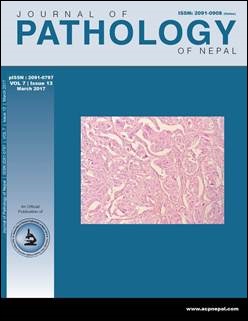Ahh! Pathology
DOI:
https://doi.org/10.3126/jpn.v7i1.16880Abstract
Pathology was introduced to us as a study of disease, a bridge between basic science and clinical medicine. So it is. We as pathologist are intrigued by the diagnostic challenges faced in everyday reporting. A benign looking lipomatous lesion appears to have a lipoblast like cells in FNAC. However, the diagnosis is made guardedly considering it to be in the external surface and differential diagnosis of atypical lipoma or a hybernoma is given. Yes, we need peer reviews and further molecular tests in order to “narrow down” our possible differential diagnosis in the not so clear cases. This brings us to the undercurrent topic that lingers among some of the medical personals regarding pathology and its future.
I, not so long ago, was asked to read an article regarding the future of pathology and its rather bleak prospect. Of course I ignored it feeling not in my life time. However, we cannot deny the surge of molecular analysis in the field of medicine and pathology is certainly not immune to it. On trying to find out some more on this topic I came across an interesting article by Juan Rosai.1 Now, to tell you the truth, the name itself was a big relief to calm down my nerves because Rosai is a genius. A Sherlock Homes of disease diagnosis. Written a decade ago, the article is relevant even today specially in our context. The failure to recognize the power of morphological analysis in H and E by a SKILLED observer has led to the increasing prediction of the demise of conventional microscopy. He states that “ Any new technique must provide information of prognostic or therapeutic significance beyond that provided by the current gold standard”.1 In 2006, National cancer institute in USA funded a $ 100 million project to have a new classification of tumors based on molecular parameters. One of the cancer biologist Lawrence Loeb said at the end of the study that “ From my perspective it is hopeless. It is a wonderful study, but there is no core of genes associated with a particular cancer. It stated with a wonderful optimism, but now it presents enormous complexity”.
Though complexities might be necessary in some of instances, power of simplicity cannot be overrated. Simplicity with a bit of open mindedness and problem oriented attitude give far better results. A plethora of tests done in the initial stage without a clue of what you are looking for can be a like trying to find a needle in a haystack . What is needed for the pathologist of todays era is the ability to bridge the gap between the genotype and phenotype, a marriage of morphology with molecular diagnosis.
So let there be no doubt. The role of pathologist is even greater now then ever before. As Hess puts it, we as a pathologist of “molecular era” need to provided primary diagnosis, determine whether a specific molecular target is present before initiation of therapy, evaluate the efficacy and possibility of side effects of new therapies and also harvest and analyze tissues in therapeutic failure. So much for the end of suffering.
Downloads
Downloads
Published
How to Cite
Issue
Section
License
This license enables reusers to distribute, remix, adapt, and build upon the material in any medium or format, so long as attribution is given to the creator. The license allows for commercial use.




